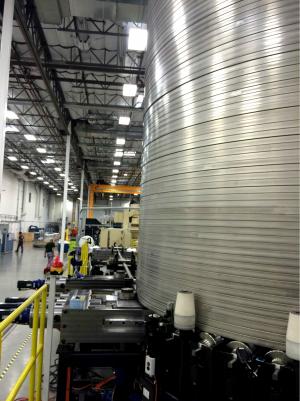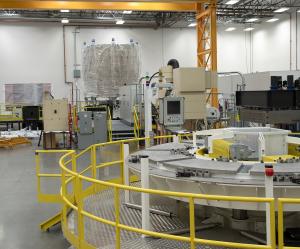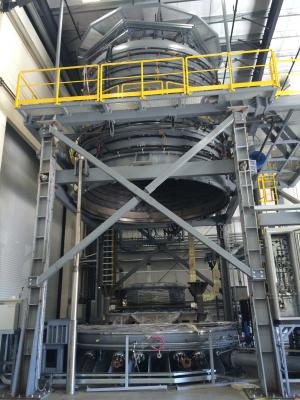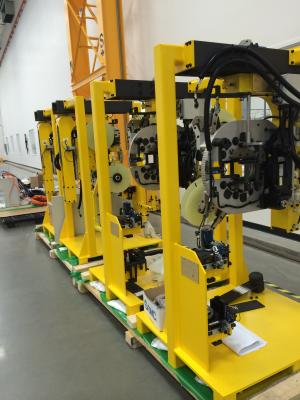Winding begins on central solenoid mockup
At the heart of the ITER tokamak is the world's most powerful pulsed superconducting electromagnet—the central solenoid.
The US ITER Project Office at Oak Ridge National Laboratory has begun fabrication of the magnet modules with vendor General Atomics. At its facility in Poway, California, General Atomics will produce six superconducting modules for the central solenoid plus a spare.
In August, General Atomics began winding a mockup central solenoid coil from non-superconducting material; the mockup is being used to confirm the readiness of the tooling stations required to fabricate a superconducting module.
The conductor arrives spooled at the facility and has to be separated by a de-spooler and fed to a winding station. The winding station forms the conductor into a spiral-wound coil composed of "pancake" layers. The mockup coil is now at the stage where the first six-layer set of wound coil, or hexapancake, is formed; the full mockup coil will comprise two hexapancakes and one four-layer quadpancake.
The winding station was designed and built by Tauring S.p.A. (Italy). After winding is completed and evaluated in late December, the mockup coil will move to other work stations for final qualification of the manufacturing process
"The approach is to qualify the fabrication process by station," says David Everitt, the central solenoid system manager at US ITER. "This begins with factory acceptance testing of workstation components, followed by assembly and commissioning, and finally production of the mockup module."
Eleven tooling stations will ultimately be installed at the vendor. While some stations support basic manufacturing tasks such as welding or stacking, others enable more complex processes such as heat treatment, wrapped turn insulation, injection of resin around the coils and cold testing.
The reaction heat treatment furnace station will make the electromagnet material superconducting by heating the niobium-tin and copper conductor to temperatures of 650 degrees Celsius. The furnace—which is 12 metres tall when opened, with a diameter of 5.5 metres—can hold one module at a time. The modules, weighing about 110 metric tons each, are moved in and out of the furnace with an air-bearing transport tool. Seco Warwick (Pennsylvania) received the subcontract from General Atomics and fabricated the furnace station at its facility in Poland.
Following heat treatment, the conductor passes to the turn insulation station, which wraps a combination of fiberglass and Kapton® tape around the conductor bars. The insulation on the conductor ensures that electrical shorts do not occur between turns and layers. The previously heat treated module needs to be un-sprung like a Slinky without overstraining the conductor, which is now strain-sensitive due to heat treatment. Once the module is un-sprung, the turn insulation machine heads (designed and built by Ridgway Machines, UK) can wrap the insulation around the conductor and then reassemble it exactly as it was before.
Following turn insulation and then ground insulation, the central solenoid modules will move to the vacuum pressure impregnation station. This station injects epoxy resin to saturate the dry turn and ground insulation materials of the module, which is critical for structural integrity and also contributes to insulation capability. The station is now under construction and will be ready for testing with the mockup module in early summer 2015. Before the first superconducting module is vacuum pressure impregnated with epoxy resin, fabrication and testing of the mockup module will be completed.
The final step for the module fabrication is cold testing at 48.5 kilo amps and 4.7 Kelvin, which is comparable to the operating conditions inside the ITER reactor. Now under design, the cold test station will be ready for the completed mockup module in February 2016. Eventually, the station will be the final proving ground for the production modules before they are prepared for shipment to the ITER site. The mockup will complete its tour of the work stations by early 2016 and the production modules are scheduled for completion by February 2019.
Further progress is also underway on the structural supports for the central solenoid. A contract has been awarded to Petersen, Inc. (Utah) for fabrication of the lower key blocks that provide the primary support for the massive 1,000-metric-ton solenoid. Procurement of the tie-plates, which provide a restraining cage around the solenoid, is now in process. Design of the assembly tooling for putting the central solenoid together at the ITER facility is also well underway; a final design review of the earliest-need items was completed in September.





